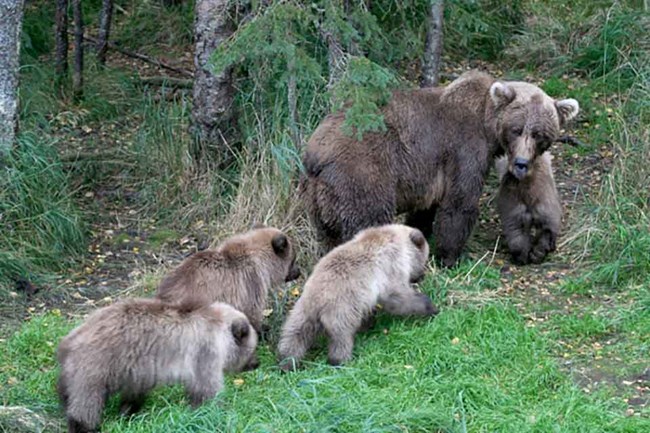Last updated: December 30, 2019
Article
Larger Brown Bear Sows are More Successful in Rearing Cubs

Recruitment of young into adulthood is key for any population. Recruitment depends on how many young are born and how many of them survive. Researchers working with four different Alaska brown bear populations looked into how the size, body condition, and age of sows related to cub recruitment. Body size was found to be the most important factor, with bigger sows recruiting more cubs than smaller bears. Older, more experienced sows were also better at recruiting cubs. Sows with poorer body condition actually showed higher recruitment, but this was likely due to the high cost of rearing cubs from milk production and sharing resources. Bears from Gates of the Arctic and Lake Clark national parks and preserves were smaller and recruited fewer cubs than bears from Kodiak Island or Katmai National Park and Preserve.
Influence of maternal body size, condition, and age on recruitment of four brown bear populations
Abstract
Recruitment of brown bear (Ursus arctos) offspring into a population is the product of initial cub production and subsequent survival and is a critical component of overall population status and trend. We investigated the relationship between maternal body size, body condition, and age (as a surrogate for gained experience) and recruitment of dependent offspring (≥1 yr old) in four Alaska, USA (2014–2017), brown bear populations using logistic regression. Body size alone was our top predictor of the presence of offspring and appeared in all top models. Our data suggest that bear size is the primary driver of productivity across all four study populations, with larger bears having a greater chance of being observed with offspring. The effect of body condition was likely confounded by the increased energetic costs of supporting cubs through time and had a negative relationship with recruitment. Age (experience) was positively related to recruitment. Understanding the relative importance of body size, body condition, and age on the recruitment of offspring provides insights into life-history trade-offs female bears must manage as they strive to meet the nutritional costs of cub production and rearing, while minimizing risks to themselves and their offspring. Further assessment of long-term longitudinal studies of brown bears that assess the lifetime reproductive output of individuals would be highly informative to further assess the effect of experience on recruitment and to support the management of brown bear populations for recovery, conservation, sustained yield, and ecosystem function.
Hilderbrand, G. V., D. D. Gustine, K. Joly, B. Mangipane, W. Leacock, M. D. Cameron, M. S. Sorum, L. S. Mangipane, and J. A. Erlenbach. 2019. Influence of maternal body size, condition, and age on recruitment of four brown bear populations. Ursus 29(2): 111-118.
